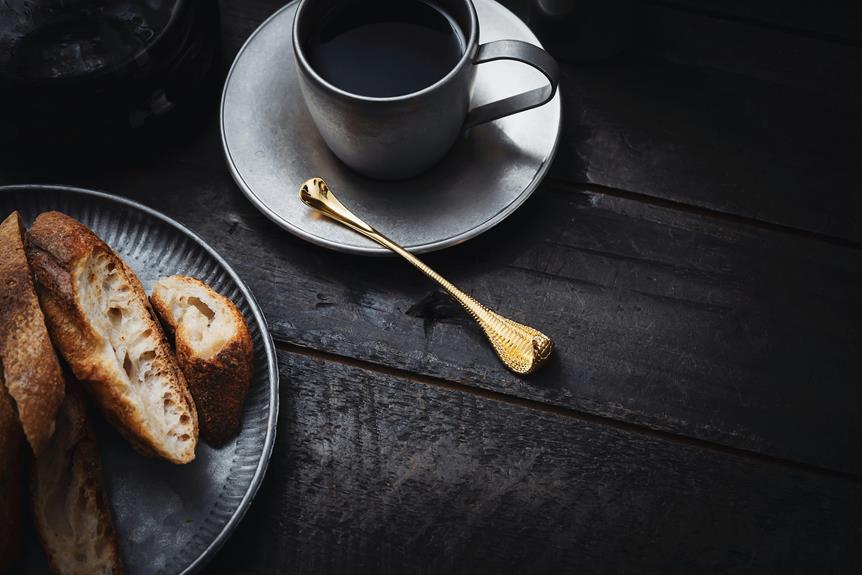I’ve discovered the secret to the perfect cup of coffee. From selecting the finest beans to mastering water temperature and grind size, the science behind brewing is an art.
Join me as we dive into the world of coffee extraction methods and learn how to achieve that ideal balance of flavors. Whether you’re a coffee enthusiast or just starting your journey, understanding these key elements will elevate your morning brew to new heights.
Let’s brew up perfection together!
Coffee Beans: The Foundation of Flavor
When brewing the perfect cup of coffee, my starting point is always the quality and origin of the coffee beans. The roasting process plays a crucial role in developing the rich flavor profiles that I cherish in my daily brew. Each bean carries a story within it, reflecting the soil, climate, and care it received before reaching my cup.
Exploring different origins and roasting levels allows me to experience a diverse range of flavor profiles, from fruity and floral notes to deep, chocolatey undertones. I find comfort in knowing that each sip connects me to the craftsmanship of the farmers and roasters who’ve perfected their art over generations.
Understanding the intricacies of the roasting process not only deepens my appreciation for the drink but also enhances my sense of belonging to a community that values the nuances of coffee culture. As I continue on my coffee journey, I’m eager to discover new beans and flavor profiles that will enrich my daily ritual even further.
Water Temperature and Extraction
Continuing from my exploration of coffee beans as the foundation of flavor, I delve into the crucial role that water temperature and extraction play in brewing the perfect cup of coffee.
When it comes to water temperature, it’s not just about getting it hot. The ideal temperature for brewing coffee is around 195-205°F, as this range ensures proper extraction without scalding the coffee grounds. The brewing time is equally significant; it affects the coffee’s acidity and flavor balance. Shorter brewing times often result in a brighter, more acidic cup, while longer extraction times can lead to a richer, fuller-bodied brew.
Moreover, water quality is often overlooked but is vital for a great cup of coffee. Using clean, filtered water can make a noticeable difference in the taste of your brew. Water with impurities or a high mineral content can mask the flavors of the coffee beans, affecting the overall quality of your drink. By paying attention to these details, you can elevate your coffee experience and savor a perfectly balanced cup every time.
Importance of Grind Size
Exploring the importance of grind size in brewing the perfect cup of coffee, I focus on achieving optimal extraction by adjusting the coarseness or fineness of the coffee grounds. Grind consistency plays a crucial role in the extraction process. When the coffee grounds are more uniformly sized, they allow for a more even extraction of flavors. This uniformity ensures that all the grounds are extracted at the same rate, resulting in a balanced and flavorful cup of coffee.
Moreover, the grind size directly impacts extraction efficiency. A finer grind exposes more surface area of the coffee, leading to a quicker extraction. On the other hand, a coarser grind slows down the extraction process. By fine-tuning the grind size, one can control the extraction rate, influencing the strength and taste of the final brew.
In essence, understanding the significance of grind size and striving for consistency can elevate your coffee brewing experience by enhancing extraction efficiency and ultimately producing a more satisfying cup of coffee.
Brewing Methods and Techniques
To brew the perfect cup of coffee, I rely on various brewing methods and techniques that enhance flavor and aroma. When it comes to pour-over precision, I meticulously control the water flow and extraction time to achieve a balanced and rich brew. This method allows me to highlight the unique characteristics of different coffee beans, bringing out their distinct flavors with clarity.
On the other hand, immersion brewing is another technique I employ to create a full-bodied and flavorful cup. By fully submerging the coffee grounds in water, I can extract a rich and robust taste profile. Immersion brewing is particularly great for highlighting the natural sweetness of the coffee, resulting in a smooth and satisfying brew.

coffee catering
Understanding Extraction Levels
In brewing the perfect cup of coffee, I carefully monitor the extraction levels to ensure optimal flavor extraction and balance. Understanding extraction efficiency is crucial as it impacts the taste and quality of the final brew.
Here are some key points to consider:
- Extraction Efficiency: Adjusting brewing variables such as grind size, water temperature, and brew time can significantly impact extraction efficiency. By experimenting with these factors, I can fine-tune the extraction process to achieve the desired flavor balance in my coffee.
- Flavor Balance: Different taste preferences call for varying extraction levels. Some may prefer a bolder, more intense flavor profile, while others may enjoy a smoother, milder taste. By understanding how extraction levels influence flavor balance, I can tailor my brewing technique to suit my taste preferences perfectly.
- Brewing Variables and Taste Preferences: It’s essential to consider how brewing variables interact with personal taste preferences. By being mindful of these factors and adjusting extraction levels accordingly, I can consistently brew a cup of coffee that resonates with my unique flavor preferences.